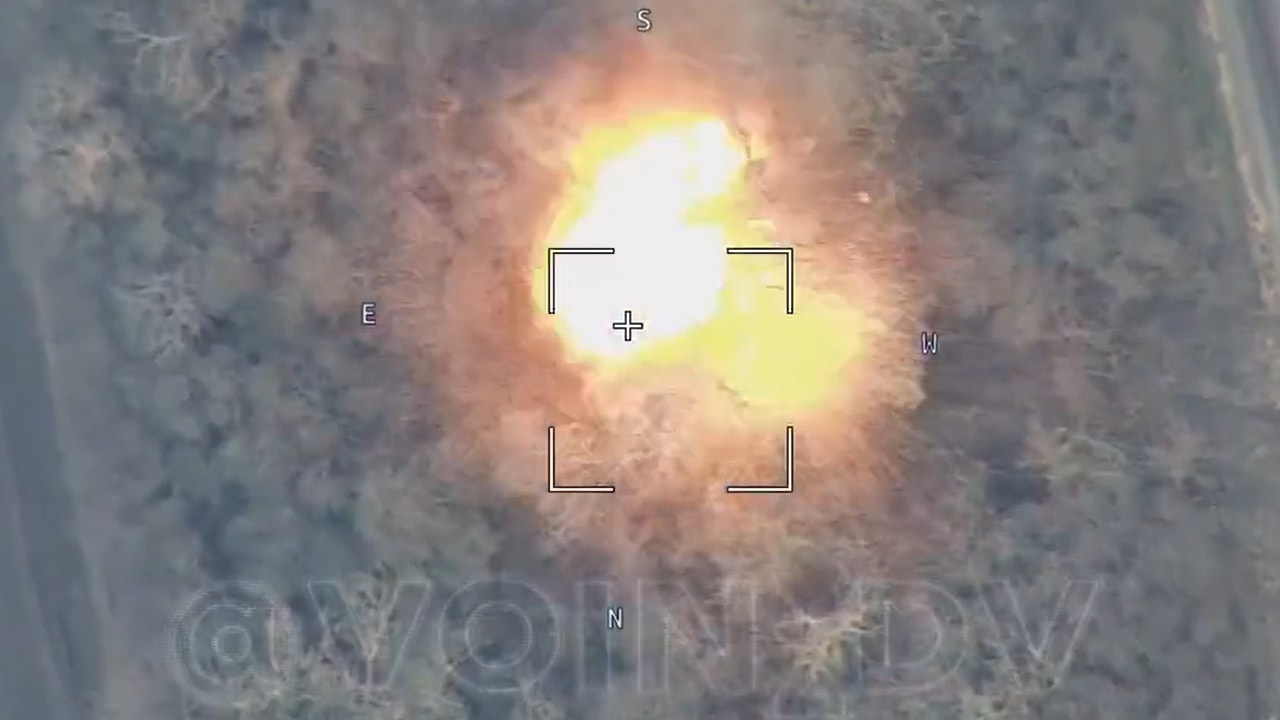Videos shared on social media have made it abundantly clear that a disabled vehicle in Ukraine is likely easy prey for unmanned aerial vehicles (UAVs) that can circle much like vultures over a dying man.
Such was the case of a Russian MT-LB, which appeared to be abandoned after becoming bogged down on a dirt road near a lake.
It was thoroughly destroyed by three modified 40x53mm HEDP (high explosive dual purpose) grenades. Such ordnance is more than capable of defeating light armor and incapacitating personnel, out to a maximum range of 400 Meters (.24 miles). The impact-type round can penetrate up to two inches of steel armor at 0-degree obliquity.
The trio of grenades was dropped with near pinpoint precision and subsequently ensured that there was no chance the armored personnel carrier would be recovered by Russian forces.
Soldiers from the 110th Separate Mechanized Brigade – named after Ukrainian nationalist and military commander Marko Bezruchko – operated the drone employed in this weekend’s action. The unit was forced last April and has been engaged in fighting in Donbas over the past year.
The two-minute-long video, which was posted to social media by Ukraine Weapons Tracker (@UAWeapons) on Sunday afternoon, was reportedly recorded by the unit. The clip had the watermark insignia of the brigade and had first appeared on the unit’s Facebook page – where the 110th often shares such exploits.
War in the Donbas
The incident occurred near the village of Opytne, in the Pokrovsk Raion (district) in the Donetsk Oblast – the site of heavy fighting in recent months. The village had already become one of the frontlines in the War in Donbas that began in 2014, and nearly the entire settlement had been destroyed. Since last November, it has been in the hands of militia forces of the so-called Donetsk People’s Republic (DPR), which are supported by the Russian Army.
The three grenades dropped by the UAV ensured that one of the Kremlin’s war machines wouldn’t be returned to the fight. The Cold War-era APC, which has been in service since the 1970s, is among the older military platforms that have been deployed to the frontlines in the Donbas region. However, Russia has been forced to refurbish old tanks and vehicles from its storage facilities including BMP-1 infantry fighting vehicles (IFVs) and even T-62 tanks.
Of course, DPR militia forces – who have been fighting in the region for nearly a decade – have resorted to restoring even older vehicles. It was in the area around the village that the pro-Russian separatists had restored a World War II-era IS-3 tank; stealing it from a war memorial to aid in their fight against Kyiv’s forces. That tank was apparently destroyed in past fighting. It is now joined by the Russian MT-LB.
#Ukraine: A stuck Russian MT-LB armored personnel carrier was destroyed by three modified 40x53mm HEDP grenades, dropped from a drone of the 110th Mechanized Brigade in Opytne, #Donetsk Oblast. pic.twitter.com/mFcvfpKiSu
— ???????? Ukraine Weapons Tracker (@UAWeapons) April 16, 2023
Author Experience and Expertise:
A Senior Editor for 19FortyFive, Peter Suciu is a Michigan-based writer. He has contributed to more than four dozen magazines, newspapers, and websites with over 3,200 published pieces over a twenty-year career in journalism. He regularly writes about military hardware, firearms history, cybersecurity, politics, and international affairs. Peter is also a Contributing Writer for Forbes and Clearance Jobs. You can follow him on Twitter: @PeterSuciu.

